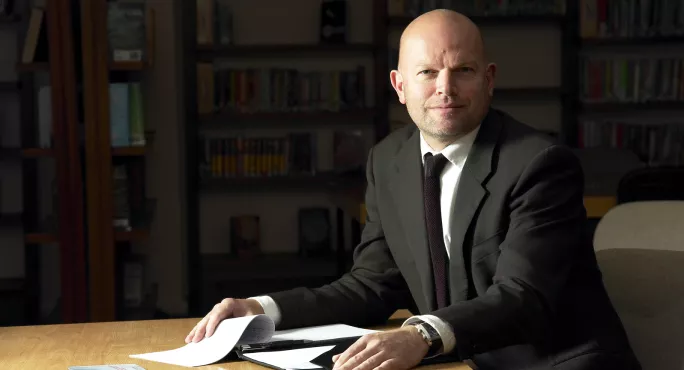- Home
- Long Read: Big rewards and ‘really harsh’ punishments - meet the man who says he has a behaviour silver bullet
Long Read: Big rewards and ‘really harsh’ punishments - meet the man who says he has a behaviour silver bullet

“Punishment has to have a sting,” states Sir John Townsley, leaning back on his chair. “No-one likes that word anymore, ‘punishment’, but we are not ashamed to use it.”
Isolation, he had said earlier, has to be “really, really harsh”.
Sir John is chief executive of The Gorse Academy Trust (TGAT) in Leeds. It consists of 10 schools: four secondary, four primary, a sixth-form college and a 5 years - 16 years alternate provision centre.
And in these schools, Sir John believes, you will find the secret to successful behaviour management. In fact, Sir John would go as far as to say that where you see good behaviour management in schools, you are probably looking at a version of a system he developed.
That system is essentially based on two triangles: one with rewards and one with sanctions. On each, the level of severity or size of reward increases as a student progresses up to the peak.
“In 1998, we set up the original pyramids for ‘zero-tolerance’ behaviour - the concept is called Positive Discipline and Behaviour,” he says. “The two ‘pyramid’ structures work up in a hierarchical sense, one for reward and one for punishment.
“The behaviour triangles are now a ubiquitous system right across the country. I’ve trained over 50 schools in Positive Discipline and in addition to that word of mouth has become a key driver [in the behaviour model spreading across the country.]”
“Influenced”, according to Sir John, by Canadian and Scandinavian approaches to behaviour, Positive Discipline and Behaviour is, he says, a “clear, tight model for punishing and sanctioning behaviour that is absolutely not open to discussion or negotiation”.
Behaviour management approach
A quick google of ‘Positive Discipline’ will throw up the work of Alfred Adler, an Austrian medical doctor and psychotherapist, and Rudolf Dreikurs, an Austrian psychiatrist and educator. They believed that while children should be treated with respect, spoiling and pampering them results in social and behavioural problems.
And in 1981, Dr Jane Nelson, an American therapist and counsellor, wrote and self-published Positive Discipline - a guide to behaviour for parents and teachers.
The themes of Adler, Dreikurs and Nelson’s work - mutual respect, consistency and community - have similarities with TGAT’s policy. Sir John would not respond to questions about the similarities, but he had previously made it clear that it was he and a team of his teachers who, in 1998, created something unique for schools in the form of a distinct policy of Positive Discipline, based on trips to Canada and Scandinavia.
“When visiting Canada, we learnt that if you don’t have complete consistency in schools, you have a recipe for disaster,” he says. “From Scandinavia, we learnt the importance of an uncomplicated, simple, clear structure that can be understood by all.
“We started then to understand what would start to form what we saw as a model that would work in English secondary schools and that’s where positive discipline came from.”
For many teachers, it probably sounds like the basic rewards and sanctions policies that have been in place for decades in most classrooms: is he sure that no-one was doing this before he did it?
When asked, he again declined to comment.
Holding the line
The themes of complete consistency and clarity are immediately evident when you visit a TGAT school. All pupils know that if they do X, Y will happen. The circumstances of the incident do not matter, neither does the pupils’ past behaviour record, or home life.
Sanctions for behaviour in both primary and secondary schools start with verbal warnings and move onto detention. At the top of the sanction triangles sit isolation and exclusion - for secondary schools, pupils can be put in isolation for a maximum of five days, in primary schools, the maximum is one day.
When it comes to praising the pupils, in both primary and secondary, a lot of focus is given to the importance of procuring ‘credits’.
Credits are rewarded both within and outside of the classroom and are documented in the student’s planner. When a student reaches a total of 50 credits, they receive a bronze award. As the number of credits increases, so does the importance of the certificate.
The highest certificate a pupil can achieve is ‘The (enter school here) exceptional achievement certificate’ - it takes 2,000 credits to earn this.
There are teachers who will say they have worked in schools with a similar model and claim it has not worked. Sir John has little time for such comments, suggesting that if it did not work then it was simply being done badly.
“The model has become so widely spread - schools across the country have taken the diagrams and models, but not the training that goes with it,” he says. “And actually, the training is really important because it’s the language, the attitudes and the approaches behind positive discipline that make it work.
“If you get great behaviour systems in place, but the teaching is largely uninspiring, then you’ve got big problems. It can’t just be bolted onto a school - everyone needs to be fully trained and properly behind it.’
The details of the training were not divulged when more information was requested, but what Sir John did say was that an integral lesson was learning how to hold the line.
The major rewards trip
He recalls an incident that involved a group of students at one of the trust’s schools, a bullying incident and a ‘major rewards’ trip.
The rules surrounding any ‘major rewards’ trip are simple - if you’ve been put into isolation or have been excluded, you cannot go.
Of the students involved in the bullying incident, Sir John describes two as ‘hangers on’. But all were placed in isolation. The two ‘hangers on’ both had exemplary behaviour records and, following the sanctions, were model pupils.
Both sets of parents visited the school and had meetings with the SLT to appeal the rules.
‘They argued that the pupils should be allowed to go on the trip because it would represent a valuable lesson for all pupils about what happens when you turn a corner, or recover from a setback,” he recalls. “There were lots of valid reasons, but the answer was no. And it will always be no.’
Sir John recognises that his approach is not always something parents will support.
“Holding the line isn’t a popular thing, and parents don’t always support that level of rigour,” he admits. “The parents and those in the community who don’t support you are like rain water: they will find their way in to the weakest part of the structure of the organisation, and you can’t have those weaknesses.”
He says that staff need to similarly believe in the validity of the process.
“If the support from the staff is pretense, that’s where it fails and that’s where it won’t work,” he says. “And the boss, whoever that is, has got to absolutely and infatuatedly believe in this system.”

At Hillcrest Academy, one of the TGAT’s primary schools, the walls are bursting with bright, proud displays of not just the children’s work, but pictures of the children themselves. The school motto: ‘With courage we dare to achieve beyond expectation’ is big and bold in the reception hall, and hanging from the ceiling in the canteen are two bikes.
At the end of the school year, if the children behave perfectly throughout the entire school year, receiving no sanctions of any kind, they will receive as a reward one of those bikes.
The rewards are just as important as the sanctions, says director of primary education and former principal Mark Randall.
“We’re in the top 3 per cent of the country for deprivation, we’ve got 43 languages spoken in the school, 50 per cent of pupils are EAL or new to English, 20 per cent have SEND or learning difficulties and over 50 per cent are on free school meals,” he says. ‘‘These families are coming from extreme poverty and difficult home lives. The classrooms and the school needs to be a wonderful environment.”
The primary school hit the headlines in 2012 after receiving an “inadequate” Ofsted report. News reports revealed that 40 pupils had been fixed or permanently excluded that year and The Yorkshire Evening Post reported that the school was receiving the “highest level of behaviour support” from Leeds City Council.
“[I found] children weren’t engaged, challenged and had no aspiration,” says headteacher Sam Done, who joined the school in 2016. “It was a culture of these children can’t achieve anything, whether they’re EAL, or white British from a council estate.”
It was only when the school joined the TGAT in 2015 and implemented the positive discipline model that everything changed, he says.
“Sir John was seen as the saviour of Hillcrest,” says Done. “We’re ‘outstanding’ and we’ve now got parents who attended as children - and were moved out of the school because of its low standards - who are choosing this school for their children.”
‘Isolated in the fullest sense of the word’
On the other side of the city is one of the Trust’s secondary schools: The Ruth Gorse Academy. Like Hillcrest, Ruth Gorse prides itself on being multicultural. A huge map of the world indicating where pupils were born, and have travelled from, has a prominent place in the entrance hall, and pictures of the entire school community are everywhere.
It’s a bright, welcoming, modern building in which pupils happily bustle from classroom to classroom, and play around while waiting in the queue for lunch.
Although described as unapologetically strict by Sir John, the behaviour policy does not require pupils to walk in silence along the corridors.
But down a long corridor, there is a room in which pupils are sent if they reach phase five of seven of the secondary sanction pyramid (the primary sanction pyramid has six phases): isolation.
On the day(s) of isolation, pupils have to arrive at 8.25am and leave at 3.00pm, are given 15 minutes to eat lunch at whichever partitioned desks they are seated and at no time allowed to socialise with other students. The school’s policy says: “Students will be isolated in the fullest sense of the word.”

“Some students have been living the lives of ‘Elvis Presley: the Vegas Years’, and then suddenly when they arrive at our schools, a lot more is expected of them,” says Sir John. “They think they can do what they want to do, on their own terms. It’s not an adversarial thing, we don’t want to be like that.
“But do you know what? To start off with you have to be like that. If we don’t sort out standards, attitudes, aspirations, routines and a culture of rigour in Year 7, we’ve had it.”
And when the children get used to it, do they begin to embrace the approach?
“The great majority of children will welcome positive discipline - sometimes privately - but they do welcome it,” says Sir John. “Most children actually want consistency, clarity, security and predictably in the regime of the day.
“A young person, from a chaotic background with very little, needs to be working and operating in exactly the same way as everyone else. When they reach 17 and are applying for a place on a modern apprenticeship, it’s no good saying I did badly in my GCSEs, but I came from a really tough background.”
No-one is interested in the back stories, believes Sir John - and therefore he says the greatest gift a school can give a disadvantaged or vulnerable child is rigorous tough love, and the education and wider opportunities that sit alongside that.
It seems the pupils spoken to at The Ruth Gorse Academy do understand, appreciate and agree with the tough love approach.
In isolation that day was a girl with purple hair. The colour of her hair was the sole reason for her being there. While talking to her peers in an art classroom, I asked them what they thought about this - to be clear, she hadn’t disrupted any classes, she hadn’t hurt anyone.
The pupils all agreed, unanimously, that it was right for her to be in isolation.
Sir John says these may seem like small things, but they are very important.
“If you’ve got a nonchalant attitude towards uniform, then don’t come to one of our schools,” he states.
In such a zero-tolerance environment, how do children with SEND or extenuating circumstances fare?
Many schools will adjust behaviour policies to suit a context or diagnosis of SEND and many teachers will informally adjust responses to behaviour owing to knowledge of a child’s home life.
Reasonable adjustment
Sir John says changes are made if absolutely necessary, but he feels “reasonable adjustment” is potentially hugely damaging.
“Others won’t say this, but I will: reasonable adjustment destroys positive discipline and destroys effective schools,” he argues.
Reasonable adjustment, he says, was originally about ensuring a child with a disability has an adjustment made so they enjoy full and equal access to everything everyone is doing. But he feels the requests now often make things worse, not better, for children.
“What we get at TGAT are constant demands from agencies to soften, to undermine our processes in the interests of reasonable adjustment,” he says. “When actually it’s the last thing that child needs.
“Under reasonable adjustment, we will get people contacting us from complex needs in Leeds asking: can Chloe go in and just do one hour in isolation the morning, go for a walk around the school at 10 o’clock, have a session with her mentor at two o’clock and the answer from us is always no.
“There is evidence of reasonable adjustment being used far too carelessly in many schools. [But] of course, where appropriate, reasonable adjustments are of great importance in ensuring equality of opportunity. This would apply regarding SEND or issues around mental health.”
Criticisms of ‘no-excuses’ behaviour models often centre on the experience of SEND children, with many reports of these students either leaving voluntarily for another school or feeling that they are being pushed out. There are also often criticisms of a disproportionate number of vulnerable or minority students being excluded and high exclusion rates overall.
Sir John declined to divulge exclusions information for the Trust or address this point directly. What he will admit is that the way the school handles behaviour does mean some parents choose to look elsewhere for a school.
‘What we do have is a range of parents choosing not to send their children to us in the first place,” he says.
In total, the Trust educates 7,850 students from the ages of 4 to 18. Of the schools inspected since being under the Trust umbrella, two are rated “requires improvement”, two are rated “good” and four are rated “outstanding”.
Sir John believes if you visit these schools, you will see an environment where behaviour is as good as it gets. And he has a challenge for you:
“If you find another academy chain who has the same standard of behaviour as us, but approaches behaviour differently, I’d love to see how they do it. Because I’ve certainly never come across one.”
Want to keep up with the latest education news and opinion? Follow Tes on Twitter and Instagram, and like Tes on Facebook
Keep reading for just £1 per month
You've reached your limit of free articles this month. Subscribe for £1 per month for three months and get:
- Unlimited access to all Tes magazine content
- Exclusive subscriber-only stories
- Award-winning email newsletters



